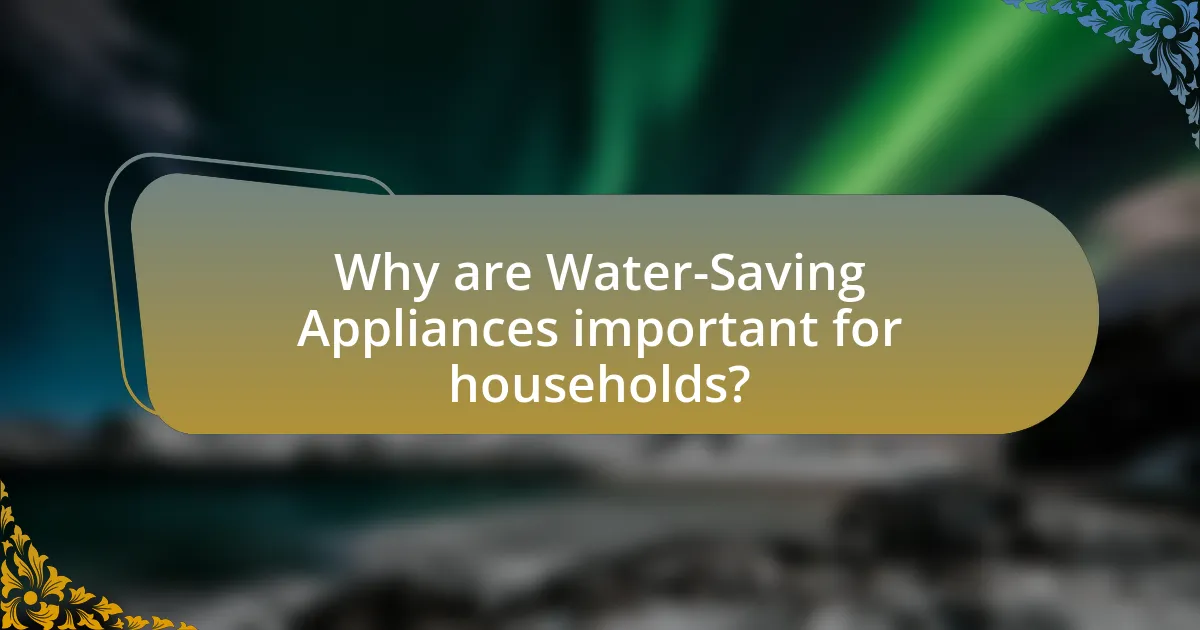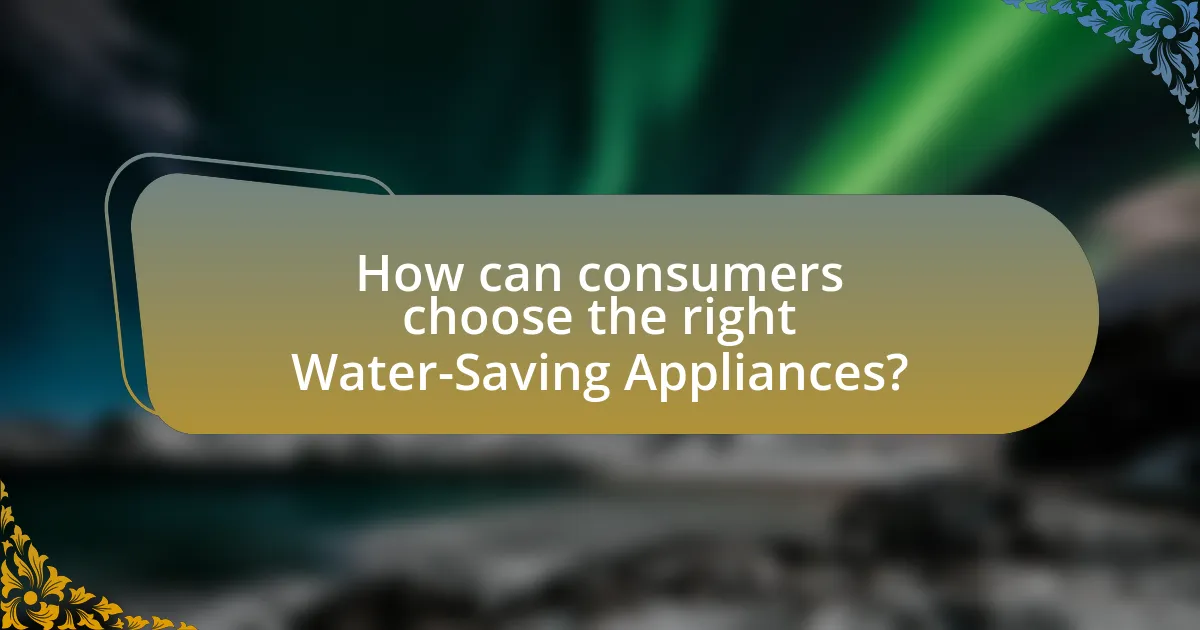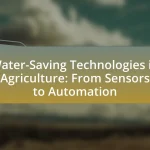Water-saving appliances are designed to reduce water consumption while maintaining efficiency in household tasks. This article explores the various types of water-saving appliances, including low-flow showerheads, dual-flush toilets, and water-efficient washing machines, highlighting their advanced technologies and functionalities that lead to significant water conservation. It also discusses the environmental impacts, health benefits, and financial savings associated with these appliances, as well as practical tips for consumers on selecting and maintaining them for optimal performance. Understanding these aspects is crucial for promoting sustainable living and effective water management in both residential and commercial settings.

What are Water-Saving Appliances?
Water-saving appliances are devices designed to reduce water consumption while maintaining efficiency in various household tasks. These appliances include low-flow showerheads, dual-flush toilets, and water-efficient washing machines, which utilize advanced technology to minimize water usage. For instance, low-flow showerheads can reduce water flow to as little as 1.5 gallons per minute, compared to traditional models that use up to 5 gallons per minute. This reduction not only conserves water but also lowers utility bills, making them an effective solution for sustainable living.
How do Water-Saving Appliances function?
Water-saving appliances function by utilizing advanced technology to reduce water consumption while maintaining efficiency. For example, low-flow showerheads and faucets use aerators to mix air with water, decreasing the flow rate without sacrificing pressure. Similarly, high-efficiency toilets employ dual-flush systems or pressure-assisted mechanisms to minimize water usage per flush. According to the U.S. Environmental Protection Agency, water-saving appliances can reduce water usage by 20-60%, demonstrating their effectiveness in conserving water resources.
What technologies are used in Water-Saving Appliances?
Water-saving appliances utilize technologies such as low-flow fixtures, dual-flush toilets, and smart irrigation systems. Low-flow fixtures, including showerheads and faucets, reduce water flow rates to conserve water without sacrificing performance, often achieving flow rates of 1.5 gallons per minute or less. Dual-flush toilets offer two flushing options, allowing users to select a lower volume for liquid waste, which can save up to 67% more water compared to traditional toilets. Smart irrigation systems use sensors and weather data to optimize watering schedules, reducing water usage by up to 50% in landscaping. These technologies collectively contribute to significant water conservation efforts in residential and commercial settings.
How do these technologies reduce water consumption?
Water-saving technologies reduce water consumption by utilizing advanced mechanisms such as low-flow fixtures, smart irrigation systems, and efficient appliances. Low-flow fixtures, like showerheads and faucets, limit water flow without sacrificing performance, resulting in significant reductions in water usage. Smart irrigation systems optimize water delivery based on real-time weather data and soil moisture levels, minimizing waste during landscaping and agricultural practices. Efficient appliances, such as Energy Star-rated dishwashers and washing machines, are designed to use less water while maintaining cleaning effectiveness, further contributing to overall water savings. Collectively, these technologies can lead to reductions in household and industrial water consumption by up to 50%, as evidenced by studies from the American Water Works Association.
What types of Water-Saving Appliances are available?
Water-saving appliances include low-flow showerheads, dual-flush toilets, water-efficient washing machines, and smart irrigation systems. Low-flow showerheads reduce water usage by limiting flow rates to 2.5 gallons per minute or less, while dual-flush toilets offer two flushing options to minimize water waste. Water-efficient washing machines use up to 50% less water than standard models, and smart irrigation systems adjust watering schedules based on weather conditions, optimizing water use. These appliances collectively contribute to significant water conservation, with studies indicating that low-flow fixtures can save households up to 30% on water bills.
What are the most common types of Water-Saving Appliances?
The most common types of water-saving appliances include low-flow toilets, water-efficient showerheads, faucet aerators, and washing machines designed for water conservation. Low-flow toilets use approximately 1.28 gallons per flush compared to older models that can use up to 3.5 gallons, significantly reducing water usage. Water-efficient showerheads typically use 2.0 gallons per minute or less, while standard models can use up to 5.0 gallons per minute. Faucet aerators can reduce water flow by 30% or more without sacrificing pressure. Additionally, high-efficiency washing machines use about 15 gallons per load, compared to traditional machines that may use 40 gallons or more. These appliances collectively contribute to substantial water savings in residential settings.
How do different types compare in terms of efficiency?
Different types of water-saving appliances, such as low-flow toilets, showerheads, and dishwashers, vary significantly in efficiency. Low-flow toilets can reduce water usage by 20-60% compared to traditional models, using only 1.28 gallons per flush instead of 3.5 to 7 gallons. Low-flow showerheads typically use 1.5 to 2.5 gallons per minute, which is 30-50% less than standard models. Energy-efficient dishwashers consume about 3-5 gallons per load, compared to older models that may use 10-15 gallons. These statistics demonstrate that modern water-saving appliances are designed to maximize efficiency while minimizing water consumption, leading to substantial savings in both water and energy costs.
What are the environmental impacts of using Water-Saving Appliances?
Water-saving appliances significantly reduce water consumption, leading to lower water extraction from natural sources and decreased energy usage for water heating. This reduction in water use helps to conserve local ecosystems and maintain water quality by minimizing runoff and pollution. For instance, the U.S. Environmental Protection Agency states that water-efficient appliances can save an average household over 30,000 gallons of water annually, which translates to substantial energy savings and reduced greenhouse gas emissions associated with water treatment and distribution.
How do Water-Saving Appliances contribute to water conservation?
Water-saving appliances contribute to water conservation by significantly reducing water usage in households and commercial settings. These appliances, such as low-flow showerheads, dual-flush toilets, and efficient washing machines, are designed to use less water while maintaining performance. For instance, low-flow showerheads can reduce water flow from 2.5 gallons per minute to as low as 1.5 gallons per minute, resulting in substantial water savings. According to the U.S. Environmental Protection Agency, using water-efficient appliances can save an average family up to 20,000 gallons of water annually. This reduction in water consumption not only conserves a vital resource but also decreases energy use associated with heating water, further contributing to environmental sustainability.
What are the long-term benefits for ecosystems?
Long-term benefits for ecosystems include enhanced biodiversity, improved water quality, and increased resilience to climate change. Biodiversity is crucial as it supports ecosystem services such as pollination, nutrient cycling, and habitat stability. Improved water quality results from reduced pollution and better management practices, which can lead to healthier aquatic ecosystems. Increased resilience to climate change allows ecosystems to adapt to shifting conditions, maintaining their functionality and services. Studies have shown that ecosystems with high biodiversity are more productive and better able to withstand environmental stressors, thus reinforcing the importance of these long-term benefits.

Why are Water-Saving Appliances important for households?
Water-saving appliances are important for households because they significantly reduce water consumption, leading to lower utility bills and environmental conservation. For instance, Energy Star-rated dishwashers use about 3 gallons of water per cycle compared to older models that may use up to 10 gallons. This reduction not only saves money but also helps in preserving water resources, which is crucial in areas facing water scarcity. Additionally, households using water-saving appliances contribute to a decrease in wastewater generation, promoting better water management practices.
How do Water-Saving Appliances affect household water bills?
Water-saving appliances significantly reduce household water bills by minimizing water consumption. These appliances, such as low-flow showerheads, dual-flush toilets, and efficient dishwashers, can decrease water usage by 20-60% compared to standard models. For instance, the U.S. Environmental Protection Agency (EPA) estimates that a family can save approximately $380 annually on water bills by using WaterSense-labeled products. This reduction in water usage directly correlates to lower utility costs, making water-saving appliances a financially beneficial choice for households.
What savings can homeowners expect from using these appliances?
Homeowners can expect significant savings on their water bills by using water-saving appliances, typically ranging from 20% to 60% less water consumption compared to standard models. For instance, Energy Star-rated dishwashers use about 3.5 gallons per cycle, while older models may use up to 10 gallons. This reduction translates to an average savings of approximately $30 to $50 annually on water bills, depending on usage patterns. Additionally, the U.S. Environmental Protection Agency estimates that households can save up to 3,000 gallons of water per year by switching to water-efficient fixtures, further enhancing overall savings.
How do these appliances influence overall household water usage?
Water-saving appliances significantly reduce overall household water usage by utilizing advanced technology to minimize consumption during everyday tasks. For instance, modern dishwashers and washing machines are designed to use less water per cycle compared to older models, often saving up to 50% of water. According to the U.S. Environmental Protection Agency, using water-efficient appliances can save a family of four approximately 20,000 gallons of water annually. This reduction in water usage not only conserves a vital resource but also lowers water bills, demonstrating the effectiveness of these appliances in promoting sustainable water management in households.
What are the health benefits associated with Water-Saving Appliances?
Water-saving appliances contribute to health benefits by reducing the risk of waterborne diseases and promoting better hygiene. These appliances, such as low-flow toilets and efficient dishwashers, minimize water stagnation, which can harbor pathogens. According to the World Health Organization, improved sanitation and hygiene practices, facilitated by efficient water use, significantly lower the incidence of diseases like cholera and dysentery. Additionally, by conserving water, these appliances help maintain a sustainable water supply, which is crucial for public health, especially in areas prone to drought or water scarcity.
How do these appliances improve water quality?
Water-saving appliances improve water quality by utilizing advanced filtration systems that remove contaminants and impurities from the water supply. These appliances, such as water-efficient dishwashers and washing machines, often incorporate technologies like reverse osmosis and activated carbon filters, which effectively eliminate harmful substances like chlorine, lead, and sediment. Studies have shown that households using these appliances report a significant reduction in waterborne pollutants, leading to safer drinking water and improved overall health outcomes.
What role do they play in promoting sustainable living?
Water-saving appliances play a crucial role in promoting sustainable living by significantly reducing water consumption in households and industries. These appliances, such as low-flow showerheads, dual-flush toilets, and efficient washing machines, are designed to use less water while maintaining performance. For instance, low-flow showerheads can reduce water usage by up to 50% compared to traditional models, leading to substantial savings in both water and energy costs. Additionally, the widespread adoption of these technologies contributes to the conservation of natural water resources, helping to mitigate the effects of drought and water scarcity.

How can consumers choose the right Water-Saving Appliances?
Consumers can choose the right water-saving appliances by looking for products with high efficiency ratings, such as those certified by the Environmental Protection Agency’s WaterSense program. These appliances are designed to use less water while maintaining performance, which is crucial for reducing water consumption. For instance, WaterSense-labeled toilets use at least 20% less water than standard models, saving an average of 13,000 gallons per year for a family of four. Additionally, consumers should consider the specific needs of their household, such as the number of occupants and water usage patterns, to select appliances that best fit their lifestyle while maximizing water savings.
What features should consumers look for in Water-Saving Appliances?
Consumers should look for high-efficiency ratings, such as ENERGY STAR certification, in water-saving appliances. These ratings indicate that the appliances use significantly less water compared to standard models, often achieving reductions of 20-50% in water consumption. Additionally, features like adjustable water flow settings, dual-flush options in toilets, and smart technology that optimizes water usage based on demand can enhance water savings. Research shows that appliances with these features not only conserve water but also reduce energy costs associated with heating water, making them a financially sound choice for consumers.
How do energy efficiency ratings impact appliance selection?
Energy efficiency ratings significantly influence appliance selection by guiding consumers toward more sustainable and cost-effective choices. These ratings, often expressed as a numerical score or letter grade, indicate the energy consumption of appliances relative to their performance. For instance, appliances with higher ratings, such as Energy Star certified products, typically consume less energy, leading to lower utility bills and reduced environmental impact. According to the U.S. Department of Energy, Energy Star appliances can save consumers an average of 30% on energy costs compared to non-rated models. This financial incentive, combined with growing environmental awareness, drives consumers to prioritize energy-efficient options when making purchasing decisions.
What certifications indicate a reliable Water-Saving Appliance?
Certifications that indicate a reliable water-saving appliance include the WaterSense label, ENERGY STAR certification, and the International Organization for Standardization (ISO) 14001 certification. The WaterSense label, issued by the U.S. Environmental Protection Agency, signifies that the appliance meets specific water efficiency criteria, using at least 20% less water than standard models. ENERGY STAR certification indicates that the appliance is energy-efficient, which often correlates with water savings, as energy production and water use are interconnected. ISO 14001 certification demonstrates that the manufacturer adheres to environmental management standards, which often include water conservation practices. These certifications provide assurance that the appliance is designed to save water effectively and sustainably.
What are some common misconceptions about Water-Saving Appliances?
Common misconceptions about water-saving appliances include the belief that they are less effective than traditional models, that they compromise performance, and that they are only beneficial in drought-prone areas. Research shows that modern water-saving appliances, such as low-flow toilets and efficient dishwashers, can perform equally well or better than older models while using significantly less water. For instance, the U.S. Environmental Protection Agency (EPA) states that water-efficient toilets can save an average of 13,000 gallons of water per household annually without sacrificing performance. Additionally, many consumers think that these appliances are only necessary in regions experiencing water shortages, but they can contribute to overall water conservation and lower utility bills in any location.
Why do some people believe Water-Saving Appliances are less effective?
Some people believe Water-Saving Appliances are less effective due to concerns about their performance compared to traditional models. Critics often cite instances where these appliances do not meet their expectations for cleaning power or water pressure, leading to dissatisfaction. For example, a study by the American Society of Plumbing Engineers found that some low-flow toilets may require multiple flushes to clear waste, which can be perceived as less effective than standard toilets. Additionally, misconceptions about the technology and design of these appliances contribute to skepticism, as users may not fully understand how water-saving features operate.
How can consumers overcome these misconceptions?
Consumers can overcome misconceptions about water-saving appliances by educating themselves on their functionality and benefits. Research indicates that understanding the technology behind these appliances, such as low-flow fixtures and efficient washing machines, can dispel myths regarding performance and water usage. For instance, studies show that modern low-flow showerheads can maintain water pressure while using significantly less water, often reducing consumption by 30% or more compared to traditional models. Additionally, consumers can seek information from credible sources, such as energy efficiency programs and consumer reports, which provide data on the effectiveness and savings associated with these appliances. Engaging with community workshops or online forums can also enhance awareness and correct misunderstandings about water-saving technologies.
What are practical tips for maximizing the benefits of Water-Saving Appliances?
To maximize the benefits of water-saving appliances, users should ensure proper installation and maintenance. Proper installation guarantees that appliances operate efficiently, while regular maintenance, such as cleaning filters and checking for leaks, helps sustain their water-saving capabilities. According to the U.S. Environmental Protection Agency, water-efficient appliances can save households up to 30% on water bills, demonstrating the financial and environmental advantages of using these devices effectively.
How can users maintain their Water-Saving Appliances for optimal performance?
Users can maintain their water-saving appliances for optimal performance by regularly cleaning filters and aerators, checking for leaks, and ensuring proper installation. Regular cleaning of filters and aerators prevents clogs that can reduce efficiency, as studies show that clean components can improve water flow by up to 30%. Checking for leaks helps to conserve water and maintain appliance functionality, as even small leaks can waste significant amounts of water over time. Proper installation, following manufacturer guidelines, ensures that appliances operate as intended, maximizing their water-saving capabilities.
What habits can enhance water conservation in conjunction with these appliances?
To enhance water conservation in conjunction with water-saving appliances, individuals should adopt habits such as running dishwashers and washing machines only with full loads, which maximizes efficiency and minimizes water usage. Research indicates that using these appliances at full capacity can save up to 3,000 gallons of water annually per household. Additionally, regularly maintaining appliances to ensure they operate efficiently can prevent leaks and reduce water waste. Implementing shorter cycles for laundry and dishes when appropriate can also contribute to water savings, as modern appliances are designed to use less water while still achieving effective cleaning.

